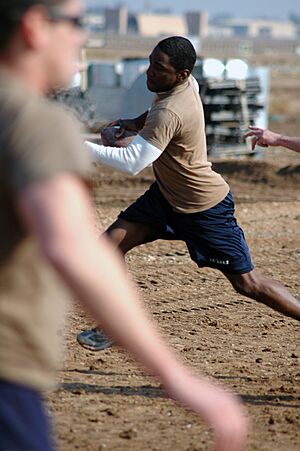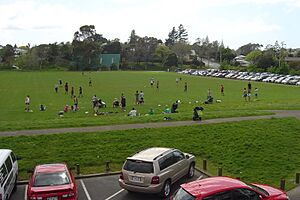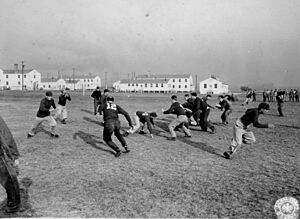Touch football (American) facts for kids
Touch football is a fun and less intense version of American football and Canadian football. It's played by many people just for enjoyment. The main difference from regular "tackle football" is how a play stops. Instead of tackling a player, you just need to touch them. This simple rule change gives the game its name! It's a bit like street football, but without the full contact.
Contents
What is Touch Football?
Touch football is a popular way to play football without the heavy contact of the professional game. It's a great way for friends and families to enjoy the sport together. The rules are similar to regular football, but they are often changed to fit where people are playing and how many players they have.
How is it Different from Tackle Football?
The biggest difference is right in the name: "touch" instead of "tackle." In tackle football, players stop an opponent by bringing them to the ground. In touch football, a play ends when a defender simply touches the ball carrier. This makes the game safer and more accessible for everyone.
Basic Rules of the Game
The rules for touch football can change a lot. It depends on the players' skills, the size of the playing area, and why they are playing.
Team Sizes and Positions
Teams can have anywhere from two to twelve players on each side. Most games usually have four to seven players per team. Unlike professional football, positions are much less strict. Often, all players can catch the ball, meaning everyone is an eligible receiver. There are usually no running backs. Sometimes, there isn't even a player who "snaps" the ball. Instead, the quarterback might just pull the ball back to start the play.
Starting the Play: The Snap and Blitz Count
Some games use a "blitz count." This is a set amount of time after the snap before defenders can cross the line of scrimmage to try and touch the quarterback. This gives the quarterback time to throw a pass, especially when there isn't much blocking. If there's no blitz count, blocking becomes more important. Also, if there's a blitz count, the quarterback usually can't run past the line of scrimmage until the count is over. This rule is called the "QB sneak" rule.
Because of these rules, throwing the ball (passing plays) is much more common than running with the ball in touch football.
Field Size and First Downs
The size of the playing field can vary a lot. Many games happen in yards or parks. The field might be as short as ten yards or much longer. Since there are often no yard lines, the way a first down is earned can change. Instead of needing to move the ball ten yards, sometimes two completed passes will earn a first down. Another option is to simply give a team four (or sometimes five) chances to score without needing first downs. This works well on shorter fields.
Sometimes, if there's an odd number of players, one player might be an "all-time Quarterback." This player always plays offense or on the kicking team, switching sides as needed. This is also known as a "Steady Quarterback." In these games, there's usually no blitz count, and the all-time quarterback cannot run past the line of scrimmage.
Scoring in Touch Football
Scoring and game timing are often simpler in touch football.
Touchdowns and Extra Points
For simplicity, touchdowns are usually worth 1 point. Other scoring, like extra points or field goals, might not be counted. This means there are no safeties either. In some games, a touchdown is worth 6 points. The player who scored can then try for a two-point conversion by running back to the opposite end zone without being touched. Games usually end when one team reaches a certain number of touchdowns (like 10) or points (like 100).
Other Ways to Score: Field Goals and Safeties
If players want to use traditional scoring but don't have goal posts, they can use "automatic" extra points. After a 6-point touchdown, teams can choose to automatically get 1 extra point (for 7 total). Or, they can risk it and try for a 2-point conversion (for 8 total).
For field goals, a "field goal zone" can be set up near the end zone. If a team is in this zone, they can choose to automatically score 3 points and then kick off to the other team. This lets teams decide if they want to try for a touchdown or take the guaranteed points.
If traditional scoring is used, a safety is worth 2 points, and the team gets the ball back with a free kick. If using the simpler "1 point-per-touchdown" system, a safety might be worth 1/2 or 1 full point, or it could just result in the other team getting the ball near their goal line.
Common Rule Variations
Many rules in touch football can be changed to make the game more fun or fair for the players.
How a Play Stops: One-Hand or Two-Hand Touch
This rule decides how many hands a defender needs to touch an offensive player to stop the play.
- One-hand touch is often used with younger players. It makes the offense try harder to dodge defenders.
- Two-hand touch requires both hands to touch the player at the same time. This needs more skill from the defender.
- A variation called rough touch means the defender must place both hands on the ball carrier with enough force to lightly push them. This helps avoid arguments about whether a touch really happened.
Starting After a Score: Kickoffs and Throw-offs
After a team scores, the ball usually changes possession. Since there are often no goal posts, teams might "throw off" the ball instead of kicking it. This gives more control.
- Half Court means the ball is thrown from the halfway line of the field. This is good for long fields but gives the kicking team an advantage by starting closer.
- No Half Court means the ball is thrown from the kicking team's own goal line.
Sometimes, players decide if the ball should be thrown to a specific person (In Hands) or just into a general area (No In Hands). "In Hands" is usually preferred because it's easier for the receiving team.
Quarterback Movement Rules
In games without a blitz count, a "first touch" rule might be used. This rule helps control how the quarterback moves.
- After the ball is handed off, a defender assigned to the quarterback (the "first touch" defender) must touch the quarterback to stop their initial forward movement. This defender cannot guard other players or block passes.
- Depending on the group, "first touch" can mean the quarterback can run after the hand-off, get touched, and still throw the ball. Or, it might mean the quarterback can only walk or power walk forward, get touched, and then throw. The first option is better for games with many players, while the second works well with fewer players.
- A "two-man touch" rule can also be added. If two defenders touch the quarterback, both defenders must "stick" to the quarterback, temporarily removing them from play. This encourages defenders to be more aware of their roles.
Touch football is often used by organized tackle football teams during practice. It helps reduce the risk of injuries and allows people of different athletic abilities and sizes to play safely.
Organizations for Touch Football
Several organizations help set rules and promote touch football.
- The National Intramural and Recreational Sports Association (NIRSA) has published a rule book for college-level flag and touch football since 1983.
- The United States Flag & Touch Football League (USFTL) was started in Cleveland, Ohio, in 1988.
See Also
- Flag football
- Street football (American)
- Touch football (rugby league)
- Touch rugby




